Panasonic eyfga1n, eyfga2n, eyfga3n Operation Manual
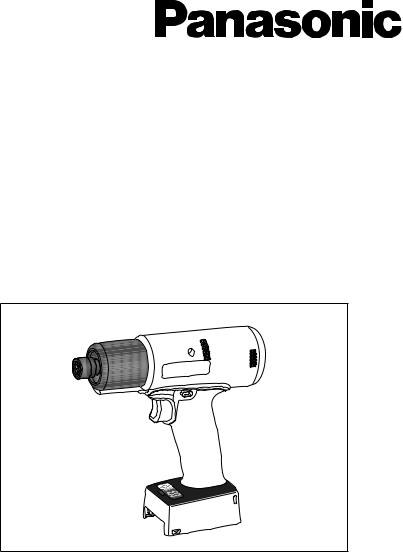
Operating Instructions
Instructions d’utilisation
Manual de instrucciones
Cordless Screwdriver
Tournevis sans fil
Destornillador inalámbrico
Model No: EYFGB1N
EYFGB2N
EYFGB3N
IMPORTANT
This manual contains safety information. Read manual completely before first using this product and save this manual for future use.
IMPORTANT
Ce manuel contient des informations de sécurité. Veuillez lire l'intégralité du manuel avant la première utilisation de ce produit et conservez ce manuel pour les utilisations futures.
IMPORTANTE
Este manual tiene información de seguridad. Lea todo el manual antes de usar este producto por primera vez y guarde el manual para poderlo consultar en el futuro.

Index/Index/Indice |
|
|
English: |
Page |
4 |
Français: |
Page |
14 |
Español: |
Página |
25 |
FUNCTIONAL DESCRIPTION
DESCRIPTION DES FONCTIONS
DESCRIPCIÓN FUNCIONAL
(C)
(B)
(A)
(J)(K) 
(L) 
(G)
(I) (H) |
(D) |
|
(E) |
||
|
(M)(F)
Clutch setting handle and battery are not included.
La poignée de réglage de l'embrayage et la batterie ne sont pas incluses.
La empuñadura de ajuste de embrague y la batería no están incluidos.
- -
(A) |
6.35 mm (1/4") hex quick connect chuck |
(B) |
Clutch shutter |
Mandrin de connexion rapide hexagonal 6,35 mm |
Volet d'embrayage |
||
|
Mandril hexagonal de conexión rápida de 6,35 mm |
|
Cierre del embrague |
(C) |
Hole for tool hanger |
(D) |
Tightening confirmation lamp |
Trou pour dispositif de suspension de l'outil |
Témoin de confirmation de serrage |
||
|
Orificio para el colgador de la herramienta |
|
Lámpara de confirmación de apriete |
(E) |
Forward/Reverse lever |
(F) |
Alignment mark |
Levier d’inversion marche avant/marche arrière |
Marques d’alignement |
||
|
Palanca de avance/marcha atrás |
|
Marcas de alineación |
(G) |
Control panel |
(H) |
LED light on/off button |
Panneau de commande |
Bouton Marche/Arrêt de la lumière DEL |
||
|
Panel de control |
|
Botón ENCENDIDO/APAGADO de luz LED |
(I) |
Battery indication lamp |
(J) |
Display |
Témoin indicateur de la batterie |
Affichage |
||
|
Lámpara de indicadora de la batería |
|
Visor |
(K) |
LED light |
(L) |
Variable speed control trigger |
Lumière DEL |
Gâchette de commande de vitesse |
||
|
Luz LED |
|
Disparador del control de velocidad variable |
(M) |
Clutch setting handle |
|
|
Poignée de réglage de l'embrayage |
|
|
|
|
Empuñadura de ajuste de embrague |
|
|
- -

EN I. GENERAL SAFETY
RULES
 WARNING! Read all instructions
WARNING! Read all instructions
Failure to follow all instructions listed below may result in electric shock, fire and/or serious injury. The term “power tool” in all of the warnings listed below refers to your mains operated (corded) power tool and battery operated (cordless) power tool.
SAVE THESE INSTRUCTIONS
Work Area Safety
1)Keep work area clean and well lit.
Cluttered or dark areas invite accidents.
2)Do not operate power tools in explosive atmospheres, such as in the presence of flammable liquids, gases or dust.
Power tools create sparks which may ignite the dust or fumes.
3)Keep children and bystanders away while operating a power tool.
Distractions can cause you to lose control.
Electrical Safety
1)Power tool plugs must match the outlet. Never modify the plug in any way. Do not use any adapter plugs with earthed (grounded) power tools.
Unmodified plugs and matching outlets will reduce risk of electric shock.
2)Avoid body contact with earthed or grounded surfaces such as pipes, radiators, ranges and refrigerators.
There is an increased risk of electric shock if your body is earthed or grounded.
3)Do not expose power tools to rain or wet conditions.
Water entering a power tool will increase the risk of electric shock.
4)Do not abuse the cord. Never use the cord for carrying, pulling or unplugging the power tool. Keep cord away from heat, oil, sharp edges or moving parts.
Damaged or entangled cords increase the risk of electric shock.
5)When operating a power tool outdoors, use an extension cord suitable for outdoor use.
Use of a cord suitable for outdoor use reduces the risk of electric shock.
Personal Safety
1)Stay alert, watch what you are doing and use common sense when operating a power tool. Do not use a power tool while you are tired or under the influence of drugs, alcohol or medication.
A moment of inattention while operating power tools may result in personal injury.
2)Use safety equipment. Always wear eye protection.
Safety equipment such as dust mask, non-skid safety shoes, hard hat, or hearing protection used for appropriate conditions will reduce personal injuries.
3)Avoid accidental starting. Ensure the switch is in the off position before plugging in.
Carrying power tools with your finger on the switch or plugging in the power tools that have the switch on invites accidents.
4)Remove any adjusting key or wrench before turning the power tool on.
A wrench or a key left attached to a rotating part of the power tool may result in personal injury.
5)Do not overreach. Keep proper footing and balance at all times.
This enables better control of the power tool in unexpected situations.
6)Dress properly. Do not wear loose clothing or jewellery. Keep your hair, clothing and gloves away from moving parts.
Loose clothes, jewellery or long hair can be caught in moving parts.
7)If devices are provided for the connection of dust extraction and collection facilities, ensure these are connected and properly used.
Use of these devices can reduce dust related hazards.
Power Tool Use and Care
1)Do not force the power tool. Use the correct power tool for your application.
The correct power tool will do the job better and safer at the rate for which it was designed.
2)Do not use the power tool if the switch does not turn it on and off.
Any power tool that cannot be controlled with the switch is dangerous and must be repaired.
3)Disconnect the plug from the power source and/or the battery pack from
--

the power tool before making any adjustments, changing accessories, or storing power tools.
Such preventive safety measures reduce the risk of starting the power tool accidentally.
4)Store idle power tools out of the reach of children and do not allow persons unfamiliar with the power tool or these instructions to operate the power tool.
Power tools are dangerous in the hands of untrained users.
5)Maintain power tools. Check for misalignment or binding of moving parts, breakage of parts and any other condition that may affect the power tools operation. If damaged, have the power tool repaired before use.
Many accidents are caused by poorly maintained power tools.
6)Keep cutting tools sharp and clean.
Properly maintained cutting tools with sharp cutting edges are less likely to bind and are easier to control.
7)Use the power tool, accessories and tool bits etc. in accordance with these instructions and in the manner intended for the particular type of power tool, taking into account the working conditions and the work to be performed.
Use of the power tool for operations different from those intended could result in a hazardous situation.
Battery Tool Use and Care
1)Ensure the switch is in the off position before inserting battery pack.
Inserting battery pack into power tools that have the switch on invites accidents.
2)Recharge only with the charger specified by the manufacturer.
A charger that is suitable for one type of battery pack may create a risk of fire when used with another battery pack.
3)Use power tools only with specifically designated battery packs.
Use of any other battery packs may create a risk of injury and fire.
4)When battery pack is not in use, keep it away from other metal objects like paper clips, coins, keys, nails, screws, or other small metal objects that can make a connection from one terminal to another.
Shorting the battery terminals together may cause burns, or a fire.
5)Under abusive conditions, liquid may EN be ejected from battery; avoid contact.
If contact accidentally occurs, flush with water. If liquid contacts eyes, additionally seek medical help.
Liquid ejected from the battery may cause irritation or burns.
Service
1)Have your power tool serviced by a qualified repair person using only identical replacement parts.
This will ensure that the safety of power tool is maintained.
II. INTENDED USE
This tool is a Cordless Screwdriver and can be used to tighten bolts, nuts, and screws with torque control.
III. ADDITIONAL
SAFETY RULES
1)Wear ear protectors when using the tool for extended periods.
2)Be aware that this tool is always in an operating condition, since it does not have to be plugged into an electrical outlet.
3)Hold power tools by insulated gripping surfaces when performing an operation where the cutting tool may contact hid den wiring or its own cord.
Contact with a “live” wire will make exposed metal parts of the tool “live” and shock the operator.
4)Do NOT operate the Forward/Reverse lever when the main switch is on. The battery will discharge rapidly and damage to the unit may occur.
5)During charging, the charger may become slightly warm. This is normal.
Do NOT charge the battery for a long period.
6)When storing or carrying the tool, set the Forward/Reverse lever to the center position (switch lock).
7)Do not strain the tool by holding the speed control trigger halfway (speed control mode) so that the motor stops.
--
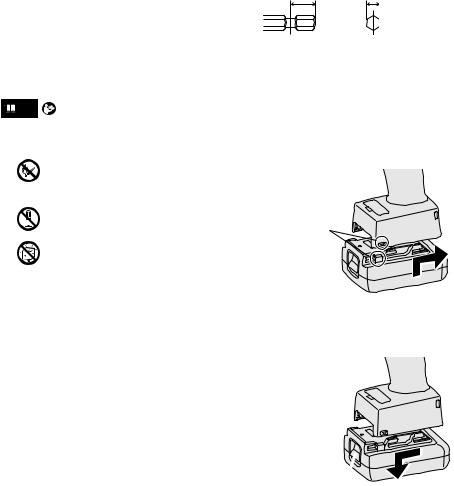
EN |
|
Symbol |
Meaning |
||||||
|
|
|
|
V |
Volts |
||||
|
|
|
|
||||||
|
|
|
|
|
|
|
|
|
|
|
|
|
|
|
|
|
|
|
Direct current |
|
|
|
|
|
|
|
|
|
|
|
|
|
|
|
|
|
|
|
|
|
|
|
|
n0 |
No load speed |
||||
|
|
|
|
|
|
|
|
|
|
|
|
… min-1 |
Revolutions or |
||||||
|
|
reciprocations per minutes |
|||||||
|
|
|
|
|
|
|
|
|
|
|
|
|
|
|
|
|
|
|
|
|
|
|
Ah |
Electrical capacity of battery |
|||||
|
|
|
pack |
||||||
|
|
|
|
|
|
|
|
|
|
|
|
|
|
|
|
|
|
|
|
|
|
|
|
|
|
|
|
|
To reduce the risk of |
|
|
|
|
|
|
|
|
|
injury, user must read and |
|
|
|
|
|
|
|
|
|
|
|
|
|
|
|
|
|
|
|
understand instruction |
|
|
|
|
|
|
|
|
|
|
|
|
|
|
|
|
|
|
|
manual. |
|
|
|
|
|
|
|
|
|
|
|
|
|
|
|
|
|
|
|
Do not incinerate or heat |
|
|
|
|
|
|
|
|
|
battery pack. Do not charge |
|
|
|
|
|
|
|
|
|
or use under conditions of |
|
|
|
|
|
|
|
|
|
high temperature. Do not ex- |
|
|
|
|
|
|
|
|
|
pose to high temperatures. |
|
|
|
|
|
|
|
|
|
Do not disassemble or |
|
|
|
|
|
|
|
|
|
modify. |
|
|
|
|
|
|
|
|
|
|
|
|
|
|
|
|
|
|
|
Do not expose to rain or |
|
|
|
|
|
|
|
|
|
water. |
|
|
|
|
|
|
|
|
|
|
IV. ASSEMBLY
Attaching or Removing Bit
NOTE:
•When attaching or removing a bit, disconnect battery pack from tool or place the switch in the center position (switch lock).
1.Hold the collar of quick connect chuck and pull it out from the tool.
2.Insert the bit into the chuck. Release the collar.
3.The collar will return to its original position when it is released.
4.Pull the bit to make sure it does not come out.
5.To remove the bit, pull out the collar in the same way.
CAUTION:
•If the collar does not return to its original position or the bit comes out when pulled on, the bit has not been properly attached. Make sure the bit is properly attached before use.
9 mm – 13 mm |
6.35 mm |
(23/64" – 33/64") |
(1/4") |
Attaching or Removing Bat tery Pack
1.To connect the battery pack:
Align the highlighted marker points and attach battery pack.
•Slide the battery pack until it locks into position.
Alignment marks
2.To remove the battery pack:
Push down the button and slide the battery pack forward.
Button 
--
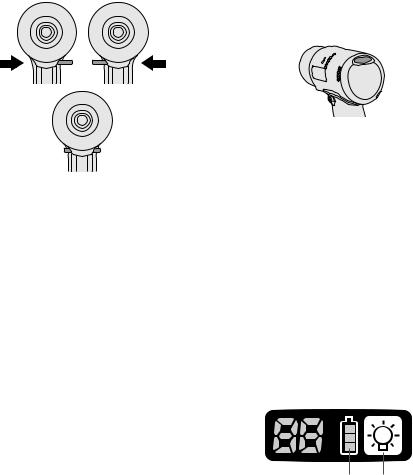
V. OPERATION
[Main Body]
Switch and Forward/Reverse
Lever Operation
Forward |
Reverse |
Switch lock
CAUTION:
To prevent damage, do not operate Forward/Reverse lever until the bit comes to a complete stop.
Forward Rotation Switch Operation
1.Push the lever for forward rotation.
2.Depress the trigger switch slightly to start the tool slowly.
3.The speed increases with the amount of depression of the trigger for efficient tightening of screws. The brake operates and the bit stops immediately when the trigger is released.
4.After use, set the lever to its center position (switch lock).
Reverse Rotation Switch
Operation
1.Push the lever for reverse rotation. Check the direction of rotation before use.
2.Depress the trigger switch slightly to start the tool slowly.
3.After use, set the lever to its center position (switch lock).
CAUTION: |
|
|
EN |
||
• To eliminate excessive temperature |
||
increase of the tool surface, do not |
|
|
operate the tool continuously using two |
|
|
or more battery packs. Tool needs cool |
|
|
off time before switching to another |
|
|
pack. |
|
Tightening confirmation lamp
•The tightening confirmation lamp can be used to check whether tightening has been completed properly.
Tool status |
Lamp display |
|
Tightening complete |
Green |
|
(For approx. 2 |
||
(Normal clutch operation) |
||
seconds) |
||
|
||
• Tightening not complete |
Red |
|
• Tightening complete |
(For approx. 2 |
|
without fulfilling the set |
seconds) |
|
function conditions |
|
|
The automatic power- |
Red |
|
off function has been |
(For approx. 5 |
|
activated. |
minutes) |
NOTE
•The tightening confirmation lamp will not turn on under the following conditions:
•During reverse rotation operation
•The lamp turns off when the tool is in operation.
Control Panel
(1)(2)
(1)The battery indication lamp
•Use the battery indication lamp to check how much power is left in the battery.
•Battery life varies slightly with ambient temperature and battery characteristics. The lamp is designed to provide a rough indication of remaining battery life.
--
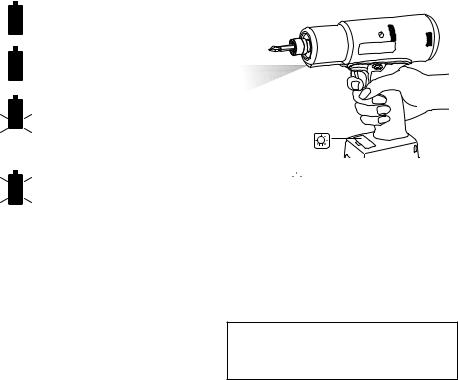
EN |
|
Indicator |
Battery status |
||||||
|
|
|
|
|
|
|
|
Fully charged |
|
|
|
|
|
|
|
|
|
|
|
|
|
|
|
|
|
|
|
|
|
|
|
|
|
|
|
|
|
|
|
|
|
|
|
|
|
|
|
|
|
|
|
|
|
|
|
|
|
|
|
|
|
|
|
|
|
|
|
|
|
|
|
|
|
|
|
|
|
|
|
|
|
|
|
|
|
|
|
|
Approx. 40% or less |
|
|
|
|
|
|
|
|
|
remaining |
|
|
|
|
|
|
|
|
|
|
|
|
|
|
|
|
|
|
|
|
|
|
|
|
|
|
|
|
|
|
|
|
|
|
|
|
|
|
|
|
|
|
|
|
|
|
|
|
|
|
|
|
|
|
|
|
|
|
|
Flashing |
|
|
|
|
|
|
|
|
|
Approx. 20% or less |
|
|
|
|
|
|
|
|
|
|
|
|
|
|
|
|
|
|
|
remaining (indicates need |
|
|
|
|
|
|
|
|
|
|
|
|
|
|
|
|
|
|
|
|
|
|
|
|
|
|
|
|
|
to recharge battery) |
|
|
Flashing |
The battery pack will need |
||||||
|
|
to be charged soon. |
|||||||
|
|
|
|
|
|
|
|
|
|
|
|
|
|
|
|
|
|
|
No charge |
|
|
|
|
|
|
|
|
|
The battery pack needs to |
|
|
|
|
|
|
|
|
|
|
|
|
|
|
|
|
|
|
|
be charged. |
|
|
|
|
|
|
|
|
|
|
|
|
|
|
|
|
|
|
|
(The tool’s automatic |
|
|
|
|
|
|
|
|
|
|
|
|
Flashing |
power-off function will |
||||||
|
|
|
|
|
|
|
|
|
activate at this stage.) |
Automatic power-off function
•The automatic power-off function is designed to prevent a loss of tightening torque due to reduced battery voltage. Once it has been activated, the tool will not operate until the battery pack has been charged (or replaced with a fresh unit), even if the trigger is depressed.
NOTE:
•All 3 bars on the battery indication lamp will flash when the automatic power-off function is activated.
•When the battery indication lamp begins flashing, the battery pack should be charged (or replaced with a fresh unit) immediately.
•Be sure to fully charge the battery pack in question after activation of the automatic power-off function. Failure to do so may prevent the automatic power-off function from being properly deactivated.
•The tool may power off automatically under heavy work loads.
However the tool will be operational again after the battery is removed and reinstalled. The battery must have a sufficient charge to re-enable the tool.
(2) LED light
Pressing the  button toggles the LED light on and off.
button toggles the LED light on and off.
The light consumes very little power and will not significantly affect battery run time.
CAUTION:
•The built-in LED light is designed to illuminate the small work area temporarily.
•Do not use it as a substitute for a regular flashlight, since it does not have enough brightness.
This tool has the built-in LED light.
Caution: DO NOT STARE INTO BEAM.
Use of controls or adjustments or performance of procedures other than those specified herein may result in hazardous radiation exposure.
- -
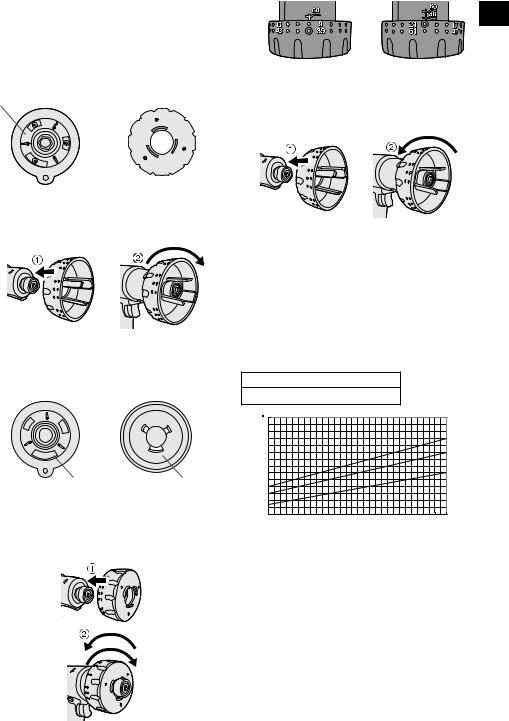
Tightening Torque Setting
1.Open the shutter with the clutch setting handle.
Front view of the |
Clutch setting handle |
main unit |
(short side view) |
Shutter (closed) |
|
EN
Example-clutch |
Example-clutch |
setting #40 |
setting #20 |
3.Close the shutter with the clutch setting handle by turning counterclockwise.
Engage the ribs on the main unit with the ribs on the clutch setting handle (on the short side) and turn clockwise.
2.Insert the 3 ribs on clutch setting handle (on the long side) into the shutter holes.
Make sure to insert the wider rib into bigger hole.
Bigger hole |
Wider rib |
To set clutch torque, turn the clutch setting handle clockwise or counterclockwise.
Clutch stage can be set from 1 to 60 stage.
(two full turns)
Decrease torque
Increase torque
NOTE:
•Be sure to close the shutter to prevent dust.
Tightening torque chart (reference values)
Thisdataconsistsofreferencevaluesmeasured under the conditions described below. During actual work, values will vary based on operating conditions (lock bolt, target substrate, method of securing the bolt in place, etc.).
Measurement conditions
As defined by Panasonic
(in·lbs)N m
(106.2) |
12 |
|
|
|
|
|
|
EYFGB3 |
|
10 |
|
|
|
|
|
|
|
|
|
|
|
|
|
|
EYFGB2 |
|
|
8 |
|
|
|
|
|
|
|
|
|
|
|
|
|
|
|
|
(53.1) |
6 |
|
|
|
|
|
|
EYFGB1 |
|
4 |
|
|
|
|
|
|
|
|
2 |
|
|
|
|
|
|
|
|
0 |
1 |
10 |
20 |
30 |
40 |
50 |
60 |
Torque setting level
CAUTION:
•Always check the tool’s tightening torque before use. Improper tool operation may result in excessive or inadequate tightening.
•Always operate the tool with the switch fully depressed.
•The torque accuracy may not be stable if the switch is not sufficiently depressed.
•Use figures from the tightening torque chart to guide your selection of torque clutch setting. (See the tightening torque chart)
--

EN Error Display
In the event of a tool or battery pack malfunction, the control panel will display an error message. Please check the tool or battery pack as described in the following chart before having them serviced.
Display |
|
Likely cause |
|
Corrective action |
The battery pack is too hot.
Stop work and allow the battery pack to cool before resuming use of the tool.
The tool is too hot to operate.
Stop work and allow the tool to cool before resuming use.
The contacts that connect the battery pack and tool are dirty.
The battery pack has not been properly inserted into the tool.
The pins on either the tool or battery pack have worn down.
Motor failure, etc.
Tool circuit malfunction, failure, etc.
Remove any dirt.
Insert the battery pack firmly into the tool.
Replace the battery pack.
Stop using the tool immediately.
- 10 -

[Battery Pack]
For Appropriate Use of Bat tery Pack
Liion Battery Pack
•For optimum battery life, store the Li-ion battery pack following use without charging it.
•When charging the battery pack, confirm that the terminals on the battery charger are free of foreign substances such as dust and water etc. Clean the terminals before charging the battery pack if any foreign substances are found on the terminals.
The life of the battery pack terminals may be affected by foreign substances such as dust and water etc. during operation.
•When battery pack is not in use, keep it away from other metal objects like: paper clips, coins, keys, nails, screws, or other small metal objects that can make a connection from one terminal to another.
Shorting the battery terminals together may cause sparks, burns or a fire.
•When operating the battery pack, make sure the work place is well ventilated.
•When the battery pack is removed from the main body of the tool, replace the battery pack cover immediately in order to prevent dust or dirt from contaminating the battery terminals and causing a short circuit.
Battery Recycling |
EN |
ATTENTION:
A Li-ion battery that is recyclable powers the product you have purchased.
Please call 18008BATTERY for information on how to recycle this battery.
[Battery Charger]
Charging
Read the operating manual for Panasonic battery charger for the battery pack before charging.
Before charging the bat tery
Charge the battery at a temperature of 5°C (41°F) to 40°C (104°F).
The battery pack cannot be charged at a temperature of less than 5°C (41°F). If the temperature of the battery pack is less than
5°C (41°F), fi rst remove the battery pack from the charger and allow it to sit for an hour in a location where the temperature is 5°C (41°F) or warmer. Then charge the battery pack again.
Battery Pack Life
The rechargeable batteries have a limited life.
If the operation time becomes extremely short after recharging, replace the battery pack with a new one.
VI. MAINTENANCE
Use only a dry, soft cloth for wiping the unit. Do not use a damp cloth, thinner, benzine, or other volatile solvents for cleaning.
- 11 -
